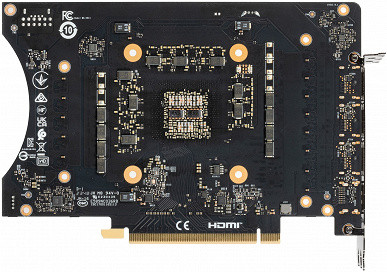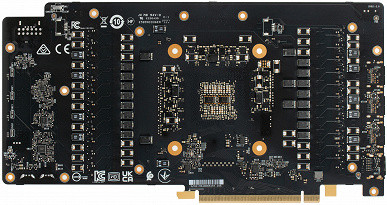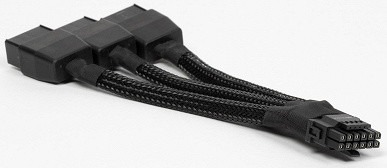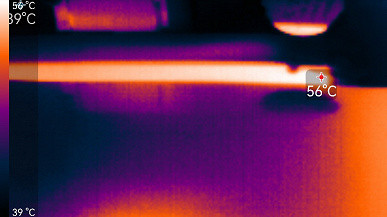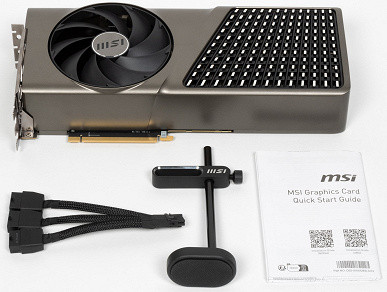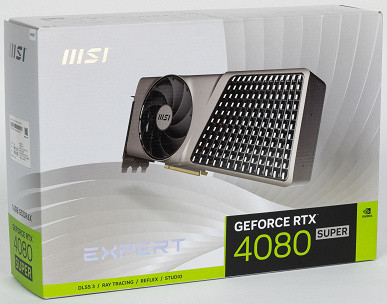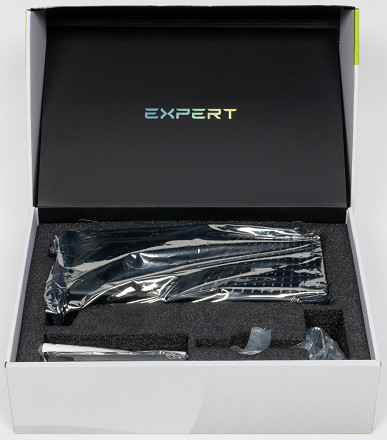Briefly about the main thing
Starting at the beginning of this year, Nvidia offered its consumers an accelerated version of the GeForce RTX 4080 — GeForce RTX 4080 Super. The recommended price of the new product was only $1,000, which is $200 lower than the base GeForce RTX 4080 model at its release ($1,200). After studying the GeForce RTX 4080 Super, it was noted that the performance increase of the new device was insignificant compared to the base model. Essentially, we got almost the same GeForce RTX 4080, but at a more affordable price. It is important to note that the initial prices for new products are often inflated, but as the GeForce RTX 4080 is removed from market shelves, prices are expected to come into line with the recommended ones.
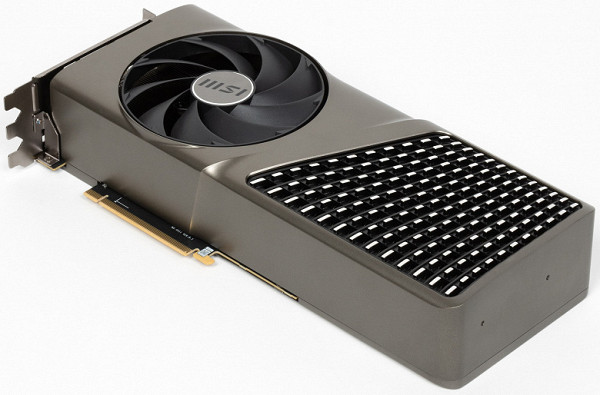
The launch of the new line of GeForce RTX 40 Super video cards was marked by the fact that MSI simultaneously introduced its completely new Expert series.
MSI is known for its core gaming series: Suprim (flagship models), Gaming/Gaming Slim (mid-range models) and Ventus (budget models), featured on all Nvidia GPUs.
The Expert series currently includes only two models — based on the GeForce RTX 4080 Super and GeForce RTX 4070 Ti Super. The Expert series logo clearly indicates that these are MSI Pro products aimed at workstations and developers. Thus, the manufacturer emphasizes that products from the Expert series can be useful not only for gamers, but also for creative professionals — content creators, modelers and other specialists. As we'll see below, MSI, based on the Nvidia Founders Edition design, has not only improved the cooling system of the new models, but also increased their aesthetic appeal.
Today we're looking at a graphics card based on the GeForce RTX 4080 Super, expecting to see a flagship product on par with the Suprim series, with its own unique features.
Before we begin detailed testing, we present a brief description of the performance of this line of video cards and their competitors. All ratings will be given on a seven-point scale, based on subjective perception.
Games without ray tracing (classic rasterization):
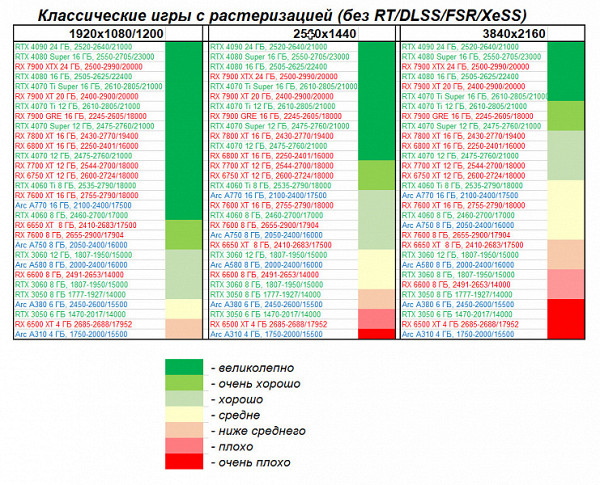
Nowadays, even in classic games at 4K resolution, performance often depends not only on the graphics card, but also on other system components, especially the processor. Video cards based on the GeForce RTX 4080 Super are firmly in the top five, taking second or third place there. They are capable of providing smooth gaming with maximum graphics settings in any resolution up to 4K, although without the use of RT and/or DLSS/FSR/XeSS technologies.
Games using ray tracing and DLSS/FSR/XeSS:

Enabling ray tracing (RT) technology usually reduces overall performance, but with scaling technologies already in place from Nvidia, AMD, and Intel, this reduction is often offset. For a powerful card like the GeForce RTX 4080 Super, the previous conclusions still apply. The MSI card, thanks to its slightly higher clock speeds, delivers performance that is approximately 3% faster than the reference.
Card characteristics
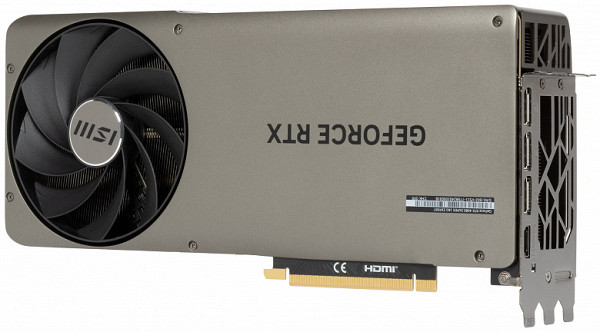

MSI (MicroStar International), founded in 1986 in the Republic of China (Taiwan), was initially engaged in the production of OEM products for orders from other companies. Its own line of products under the MSI brand was launched in 1994. The company's headquarters are located in Taipei, Taiwan. Production is distributed between China and Taiwan, and about 50% of products are manufactured under orders from third-party companies (OEM). The company began its activities on the Russian market in 1997.
| MSI GeForce RTX 4080 Super Expert 16 GB 256-bit GDDR6X | ||
|---|---|---|
| Parameter | Meaning | Nominal value (reference) |
| GPU | GeForce RTX 4080 Super (AD103) | |
| Interface | PCI Express x16 4.0 | |
| GPU operating frequency (ROPs), MHz | 2610(Boost)—2790(Max) | 2550(Boost)—2705(Max) |
| Memory operating frequency (physical (effective)), MHz | 2875 (23000) | 2875 (23000) |
| Memory bus width, bits | 256 | |
| Number of computational units in the GPU | 80 | |
| Number of operations (ALU/CUDA) in block | 128 | |
| Total number of ALU/CUDA blocks | 10240 | |
| Number of texturing units (BLF/TLF/ANIS) | 320 | |
| Number of rasterization units (ROP) | 112 | |
| Number of Ray Tracing blocks | 80 | |
| Number of tensor blocks | 320 | |
| Dimensions, mm | 310×140×60 | 310×130×70 |
| Number of slots in the system unit occupied by a video card | 3 | 4 |
| PCB color | black | black |
| Peak power consumption in 3D, W | 299 | 300 |
| Power consumption in 2D mode, W | 42 | 42 |
| Energy consumption in sleep mode, W | eleven | eleven |
| Noise level in 3D (maximum load), dBA | 34.8 | 32.0 |
| Noise level in 2D (video viewing), dBA | 18.0 | 18.0 |
| Noise level in 2D (idle), dBA | 18.0 | 18.0 |
| Video outputs | 1×HDMI 2.1, 3×DisplayPort 1.4a | 1×HDMI 2.1, 3×DisplayPort 1.4a |
| Multiprocessing support | No | |
| Maximum number of receivers/monitors for simultaneous image output | 4 | 4 |
| Power: 8-pin connectors | 0 | 0 |
| Power: 6-pin connectors | 0 | 0 |
| Power: 16-pin connectors | 1 | 1 |
| Weight of the card with delivery set (gross), kg | 2.85 | 3.0 |
| Card weight (net), kg | 1.9 | 2.2 |
| Maximum resolution/frequency, DisplayPort | 3840×2160@144 Hz, 7680×4320@60 Hz | |
| Maximum resolution/frequency, HDMI | 3840×2160@144 Hz, 7680×4320@60 Hz |
Memory
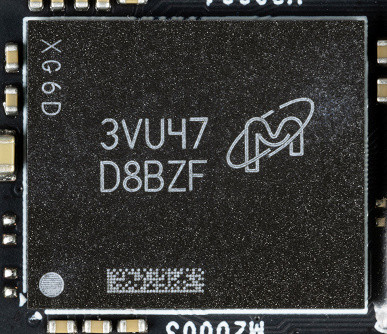
The card is equipped with 16 GB of GDDR6X SDRAM memory, which is located on the front side of the printed circuit board in 8 chips of 16 Gbit each. Memory chips from Micron (model MT61K512M32KPA-24 / D8BZF) are designed to operate at frequencies up to 3000 MHz (equivalent to 24000 MT/s).
Card features and comparison with MSI Expert GeForce RTX 4080 OC (16 GB)
We are comparing this card with the previous model from the same manufacturer, released earlier, which is logical, since the main difference is the smaller GPU. Obviously, the PCB has been completely redesigned, including adaptation to the new cooler, which requires a significantly shorter PCB. The simplification of the core power circuit is also noticeable: the number of phases has been significantly reduced. But this does not necessarily mean that the overclocking potential has decreased. However, voltage flexibility has been reduced, meaning that in some situations the card may draw more power than necessary (compared to the equivalent gaming version of the Gaming X Trio).
The core is labeled AD103-400 and was released in week 44 of 2023.

Let me remind you that this crystal was produced by TSMC (Taiwan), consists of 45.9 billion transistors and has an area of 379 mm².
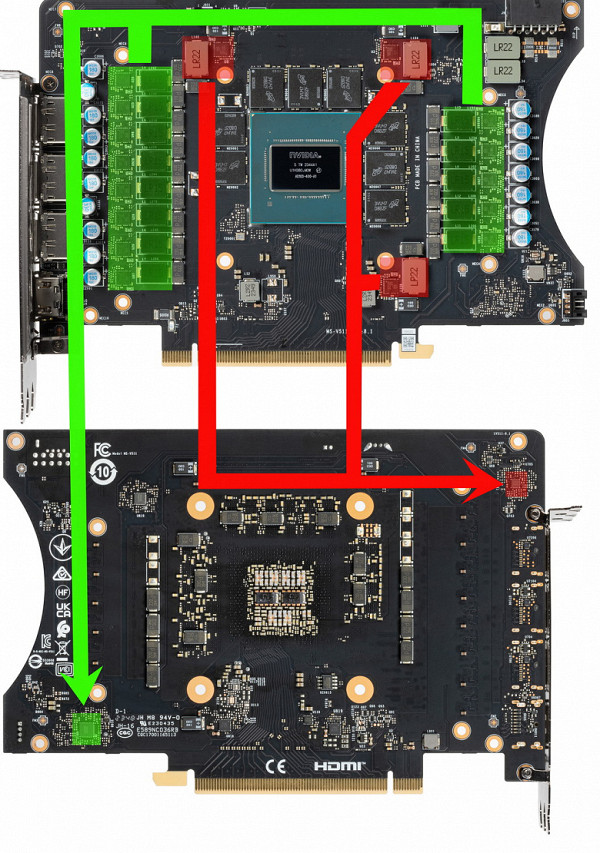
On the front side of the PCB, the power supply circuit for the core is highlighted in green, and the memory circuit is highlighted in red. All PWM controllers are located on the reverse side of the PCB.
The uP9512R PWM controller (uPI Semiconductor) controls 13 power phases for the core. Various modifications of this controller are designed to control from 8 to 12 phases. In this case, a more economical modification with 8 phases is used, so 12 phases are controlled in pairs, which ultimately forms a circuit of 7 phases: 6 × 2 + 1.
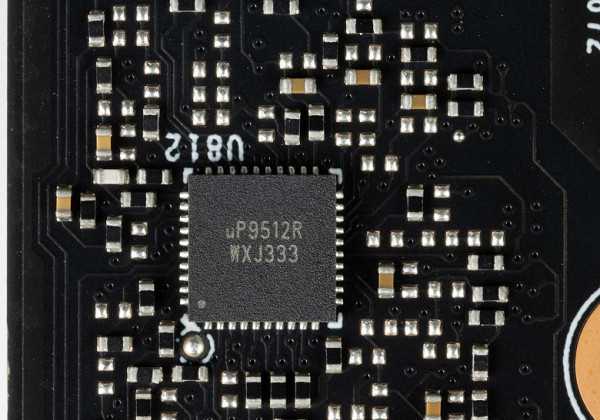
The power supply for the memory chips is controlled by the uP9529Q PWM controller (uPI Semiconductor). It is designed to control 4 phases.

The power converter uses DrMOS transistor assemblies — in this case NCP302150 (On Semi), each of which can withstand up to 50 A of current. Why such a reserve? Considering that video cards use 13 phases of power, one would think that the total current capacity is 650 A (13 phases × 50 A). However, each assembly has its own coefficient of performance (COP), which decreases as the load increases. That is why the number of phases and the choice of components for powering video cards are always calculated with a margin to ensure stable power supply and durability under extreme GPU operating conditions.
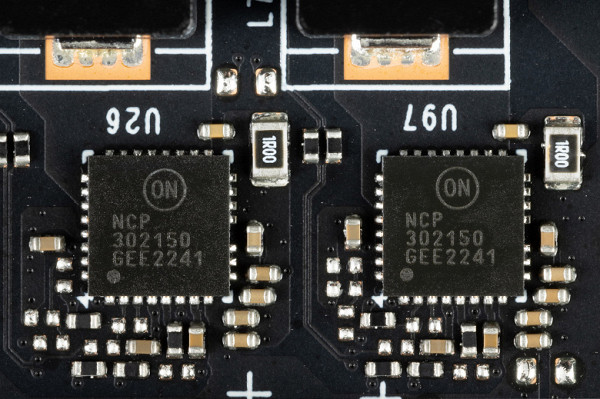
Also on the reverse side of the board there is a uS5650Q controller (uPI Semi), which is responsible for monitoring the card (monitoring voltages and temperatures).

The card is not equipped with backlighting, therefore, there is no corresponding controller for it.
Operating memory frequencies correspond to reference values. Boost core frequency value is 2.5% higher than the reference value. As a result, in games we see a 3% increase in performance compared to the reference card, thanks to higher maximum core frequencies.
The power consumption of the MSI card in tests reached 299 W, with a peak value of up to 345 W.
The maximum power consumption limit for this card can be increased to 115%. By manually overclocking and setting the consumption limit to this level, it was possible to achieve maximum frequencies of 2985 MHz for the core and 25848 MHz for memory, which led to an increase in performance in games at 4K resolution by almost 7% compared to reference values. At the same time, the power consumption of the card increased to 322 W.
The MSI card is powered via a 16-pin PCIe 5.0 (12VHPWR) connector.

The card is supplied with an adapter for such a connector from 3 regular 8-pin connectors (well known to everyone).
Let us note the standard dimensions of this card, especially in thickness: about 6 cm. As a result, the video card occupies 3 slots in the system unit.

The GeForce RTX 4080 Super does not support multi-graphics configurations such as SLI, and does not have a dedicated connector on the top for this purpose.
There are four video outputs on the back of the card: one HDMI 2.1 and three DP 1.4a. This allows you to connect up to four monitors simultaneously.
The operation of the card can be controlled through the popular MSI Afterburner utility. This program is known for its functionality and does not require much introduction, and screenshots of its interface can be seen in the monitoring section below.
Heating and cooling
The cooling system is the main feature of the entire Expert series. Let's remember how reference COs work on older Nvidia cards from the Founders Edition series since the GeForce RTX 30.
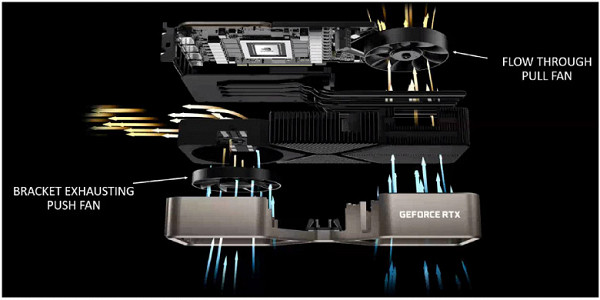
We remember that the key feature of such coolers was the use of only two fans. One of them removed hot air from the PC case as standard, and the second blew out the radiator and the card itself completely. This approach allowed for efficient cooling of Nvidia graphics cards, which typically had short PCBs with a V-shaped cutout so as not to interfere with this type of cooling.
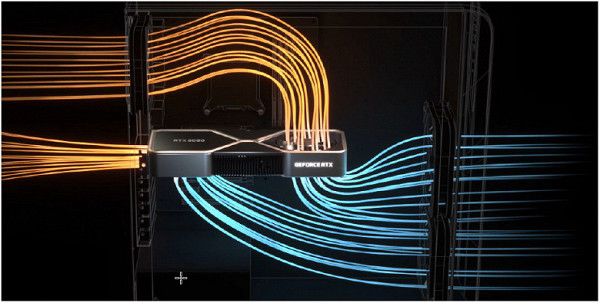
It was assumed that the hot air blown out by the right fan would be captured by the flows inside the case and then also removed from the system unit.
The main drawback of this reference cooling system, as many reviewers and users noted, was that it ran excessively hot. Despite the fact that it consisted entirely of a metal heatsink with a large number of fins and some heatpipes, for more powerful cards such as the GeForce RTX 3090, it was necessary to create a larger and significantly thicker heatsink, not to mention the GeForce RTX 4080 and GeForce RTX 4090.

Now let's look at what MSI engineers have proposed. As you can see, they used the basic Nvidia cooler concept but made significant changes.
The basis of the cooling system is a massive two-section nickel plated radiator with a sufficient number of heat pipes that effectively distribute heat across the radiator fins. These fins have V-shaped cuts to improve overall heat transfer.

Eight heat pipes are soldered to a huge nickel-plated copper plate that hides the vapor chamber. The evaporation chamber uses a low-boiling liquid to transfer heat from the heated side to the cooled side. This design was absent from Nvidia's reference coolers and helps cool the graphics card more efficiently.
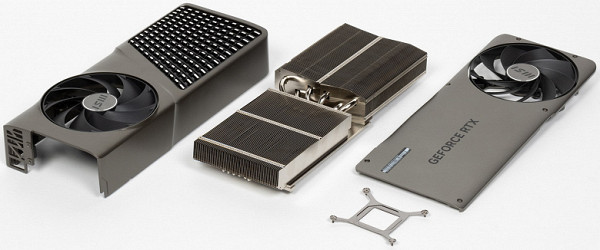
The memory chips and VRM power converters are cooled using the same huge heat sink, which is connected to them through thermal pads.
The back plate is not only equipped with an additional fan, but also serves as a cooler for the back side of the board through a thermal pad, effectively removing heat from the GPU area.
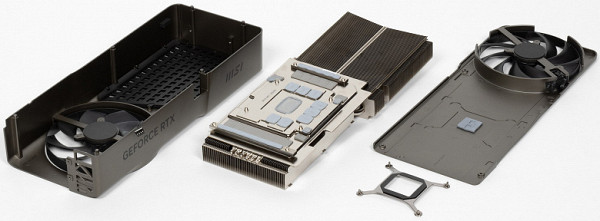
Above the radiator there is a casing with one fan with a diameter of 120 mm (a similar fan is installed on the rear plate). The blades of both fans are connected by a ring to improve the direction of air flow on the radiator. Each fan uses two ball bearings.

Taking advantage of Nvidia's CO concept, MSI has also added a stylish metal mesh design on the casing. The fans stop at low load on the video card, if the GPU temperature drops below 50 degrees, and the heating of the memory chips drops below 80 degrees. After loading the video driver, the system checks the operating temperature and automatically turns off the fans.
Temperature monitoring:

After a 2-hour run under maximum load, the video card showed that the maximum core temperature was 73 degrees Celsius, and the memory reached 68 degrees Celsius — which is an excellent result for a flagship-level card. The card's power consumption reached almost 300 W (peak 345 W), with the fans running at 1378 rpm. The temperature of the GPU hot spot reached 87 degrees Celsius.
Maximum heating was observed in the central part of the PCB.
With manual overclocking, the heating parameters remained at 74 degrees Celsius for the core and 70 degrees Celsius for the memory, but the maximum consumption increased to 322 W (peak 401 W). This led to an increase in productivity by 6.5-7%. The temperature of the GPU hot spot reached 89 degrees Celsius.

Noise
The noise measurement technique assumes that the room is soundproofed and attenuated, which reduces reverberation. The system unit used to measure video card noise has no fans, which eliminates mechanical noise. The background noise level is 18 dBA, which is the same as the room noise level and the sound level meter. Measurements are taken at a distance of 50 cm from the video card at the level of the cooling system.
Measurement modes include:
- Idle mode in 2D: an Internet browser with the site iXBT.com, a Microsoft Word window, and a number of Internet communicators are loaded.
- 2D mode with movie viewing: use SmoothVideo Project (SVP) for hardware decoding with insertion of intermediate frames.
- 3D mode with maximum load on the accelerator: testing using FurMark.
The noise level is assessed as follows:
- Less than 20 dBA: relatively silent.
- 20 to 25 dBA: very quiet.
- From 25 to 30 dBA: quiet.
- From 30 to 35 dBA: clearly audible.
- From 35 to 40 dBA: loud, but tolerable.
- Above 40 dBA: very loud.
In idle mode (2D), the temperature did not exceed 40 degrees Celsius, the fans did not rotate, and the noise level was consistent with the background — 18 dBA.
In the mode of watching movies with hardware decoding, the parameters did not change.
At maximum 3D load, the core temperature reached 73 degrees Celsius and the memory reached 68 degrees Celsius. The accelerator fans operated at 1378 rpm, while the noise level increased to 34.8 dBA, which corresponds to a clearly audible noise level, bordering on high.
The noise spectrogram shows a fairly smooth pattern, although there are pronounced peaks at low frequencies in hertz.

Do not forget that the heat generated by the card partially remains inside the system unit, so using a case with good ventilation is highly desirable.
Backlight

The map is not backlit.
Delivery and packaging
In addition to the traditional quick start guide, the package also includes a power adapter and an extendable stand.
The package includes a stand that will help cope with the sagging of the card. The stop moves along the rod and is secured with a side screw.
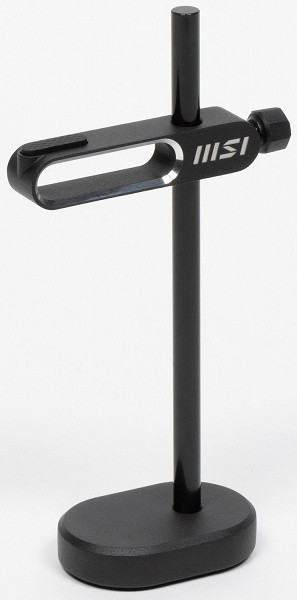
The kit also includes a power adapter from three 8-pin connectors to one 16-pin connector.
conclusions
MSI GeForce RTX 4080 Super Expert (16 GB) is a top-end accelerator with an interesting and stylish design. Although you can find GeForce RTX 4080 Super models on the market at a lower price, you have to pay extra for the original design and cooling features, as well as for the MSI brand in general.
The speed of the GeForce RTX 4080 Super exceeds its predecessor GeForce RTX 4080 by 4%-5%. The latter, in turn, had no direct analogues in the previous generation, with the exception of the GeForce RTX 3090 Ti, which approximately matches the GeForce RTX 4070 Ti in performance. In addition, all GeForce RTX 40 series cards have additional potential thanks to DLSS 3 technology. In games with ray tracing and using smart anti-aliasing technologies, they demonstrate solid results, outperforming AMD solutions of comparable price.

The MSI graphics card consumes up to 300 W of power, with possible one-time spikes above this value. The cooling system is highly powerful and efficient, but at the same time quite noisy. The dimensions of the card are 31 cm in length, 14 cm in height and it occupies 3 slots in the case. The rear panel has 3 DP 1.4a ports and 1 HDMI 2.1 port.
The card is connected via a 16-pin PCIe 5.0 power connector. The package includes an adapter adapter for connecting three PCIe 2.0 power connectors, but it is recommended to use ATX 3.0 power supplies with full support for PCIe 5.0 and a 12VHPWR cable. It is important not to bend the power adapter immediately after the 16-pin connector.
The card is not backlit and does not come with a stand. The manufacturer provides a 3-year warranty for this card.

The GeForce RTX 4080 Super is great for 4K gaming at maximum graphics levels, including ray tracing, with or without DLSS/FSR/XeSS support. Some games using DLSS/FSR/XeSS can achieve acceptable gaming comfort even at 8K resolution.
The card also supports the HDMI 2.1 standard, which allows you to output 4K images at up to 120 FPS or 8K using a single cable. It also provides hardware-based AV1 video decoding, RTX IO technology for fast data transfer from storage devices directly to the GPU, and Reflex latency-reducing technology, which is especially useful for esports athletes.



